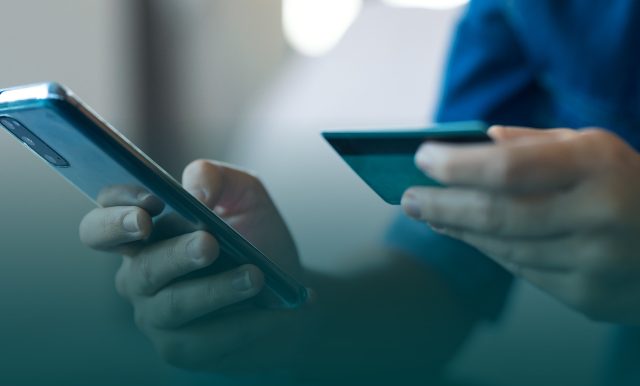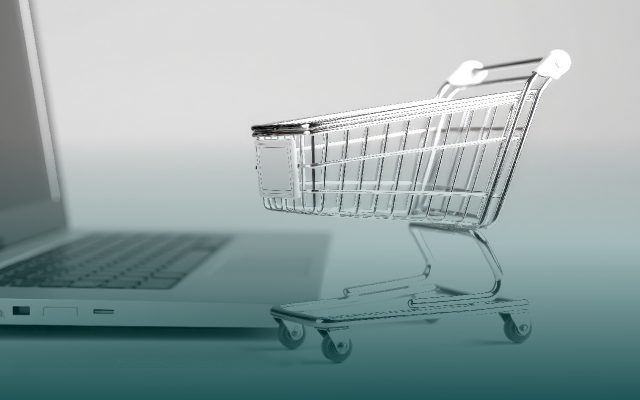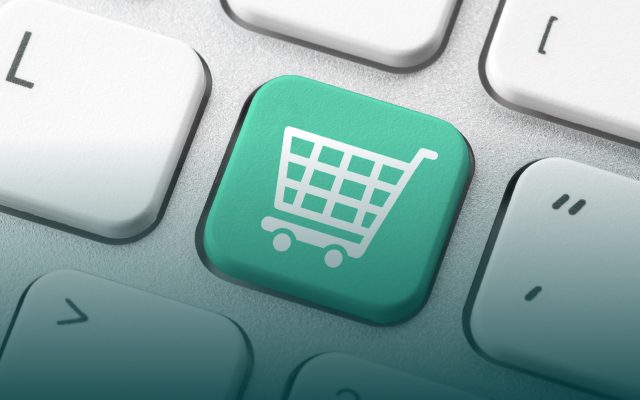When users see that their mobile phones get outdated, they easily replace them with new models. Yet, they cannot stand the fear of losing their phones. That’s because this tiny gadget stores so much valuable data on each user that losing it all at once seems like a nightmare.
Mobile devices are used in most spheres of life. With the rise of mobile payments and mobile app development, mobile commerce is also gaining momentum. Let us explain what mCommerce is and how retailers and online merchants should prepare for the growing mobile traffic.
What Is mCommerce?
We’ll answer the question “What is m-commerce?” by comparing e-commerce and m-commerce. E-commerce stands for electronic commerce. The term covers all commerce activities that occur on the Internet. For example, ecommerce activity is when a customer uses a desktop computer/tablet/laptop to access Amazon and order a product. Meantime, m-commerce is a subcategory of e-commerce. M-commerce stands for mobile commerce. It is limited to the activities that are done via a cell phone or other wireless devices. For instance, m commerce example is when a client uses a mobile phone to access an ecommerce platform and place an order there.

M-Commerce History
The term m-commerce was introduced by Kevin Duffey in 1997. At the Global Mobile Commerce Forum that took place in London, Duffey first talked about mobile commerce. By m-commerce, he meant “the way to deliver commerce capabilities via wireless technology directly to a client.” At these times, mobile ecommerce was only at the beginning of its history. Such famous companies as Motorola, Nokia, Logica, and Mastercard started to form their own m-commerce teams after participating in the forum.
The first well-known evidence of m-commerce activity happened in Finland the same year. There, Coca-Cola company installed two vending machines that accepted payments via SMS. In the 2000s, mobile commerce services continued to grow. In Norway, people got the opportunity to pay for parking via mobile devices. Austria also joined the trend and introduced mobile train ticketing.
Starting from 2007, mobile commerce was getting more and more sophisticated. It started to change consumer shopping habits. That year, Apple released its first iPhone. Technological progress has enabled mobile merchants to grow their services from primitive SMS-enabled actions to the use of well-designed and engaging applications.
Today, mobile commerce keeps growing. In the second quarter of 2022, 60% of all Internet traffic came from mobile. Vendors utilize numerous tools and practices to engage more mobile users and win their attention. This includes personalized push notifications, proximity marketing, barcode scanning, and more. We witness the emergence of a new hybrid type of commerce that combines offline and online shopping experiences. Modern merchants that offer offline services want to provide their clients with the benefits of online. They leverage the power of technology to bridge the gap between in-store and e-commerce activities. This tactic enables them to compete successfully with online vendors that offer the same products at lower prices.
Top 7 Mobile Commerce Capabilities
In 2021, global mCommerce sales crossed $350 billion, which marked a 15% increase compared to the previous year. The growth of mobile commerce is well explained in the following video:
Here are some of the main ecommerce capabilities that clients can benefit from when purchasing goods via a mobile device:
Mobile payments and money transfer
Customers use their phones or tablets to make payments for services or products. In 2021, more than 100 million US citizens used a mobile wallet (like Apple Pay or Google Pay). This stands for almost 44% of all smartphone users. By 2025, the figure is expected to cross 50%. By enabling in-app transactions or payments via mobile wallets, you can obviously reach more clients.
Mobile purchases
Mobile devices give customers access to online stores where they can order goods or services. Your website should be optimized for mobile to engage more users. Mobile websites are also perfect for implementing upselling techniques.
Mobile vouchers and special offers
Merchants offer vouchers and loyalty programs that can be activated via clients’ mobile phones. A customer uses a smartphone to display a virtual token that represents a special offer, coupon, or voucher. Also, vouchers and coupons can be implemented in location-based marketing. Whenever a client walks near the shop, they will get an engaging notification on their mobile device.
Purchases of content and digital solutions
One more capability of modern mobile commerce is selling content, mobile apps, and various digital products. People can sell, buy, and distribute songs, apps, wallpapers, and tools via mobile devices. With the growth of 4G and 5G technologies, many offline services move online and consider mobile development.
Proximity marketing
Proximity marketing is a location-based method of attracting user attention. Whenever a customer is in close proximity to the offline location, they will get personalized notifications, local discounts, product recommendations based on their purchase history, etc. This is done with the help of location-tracking technology.
Mobile Marketing
This includes special marketing techniques applied in the mobile context. Compared to traditional marketing, mobile marketing tends to be more effective. The main reason for this lies in the flexibility that mobile phones give. These devices are always with their owners, meaning that clients feel less pressure when making purchase decisions. They can proceed with their purchases anytime. This creates favorable conditions for completing the sale.
Other services
There are many other types of mobile commerce. One more capability of mobile commerce is mobile ticketing and mobile banking. Clients use their smartphones to access tickets and show them at the ticket check. M-commerce technologies enable users to access auctions, stock market services, as well as banking services via mobile.
3 M-Commerce Benefits
Before investing in m-commerce, conduct an analysis of your target audience and the devices they use to access your services. If mobile audiences constitute a great part of your site traffic, this is a good reason to consider mobile commerce.
If you have a mobile-optimized website or m-commerce app, you get plenty of benefits in front of your competitors. The top benefits that m-commerce can give you include:
- Direct reach. As mentioned above, clients take their mobile devices almost everywhere during the day. This gives you more chances and opportunities to reach your customers. Immediate access to your target audience turns a mobile device into an effective marketing channel.
- Better focus. The peculiarity of mobile screens makes commerce via a smartphone more goal-focused. On mobile, there’s a limited screen space where you can display information about a product. This makes merchants prioritize essential product information and keep things clear and simple for a client. Clients value it a lot.
- Personalization. Humans cannot remember unique data on each client. Machines can, and they do it for humans. AI algorithms use data from client profiles, purchase history, behavior on the site, etc. to increase the value and encourage customers to order more.
M-Commerce App Development Checklist
Now, you know about the main benefits that mobile ecommerce offers. If you plan to scale, conquer new niches, and reach new audience segments, you will need an m-commerce application. Here is a quick checklist for building an m-commerce app for your online business:
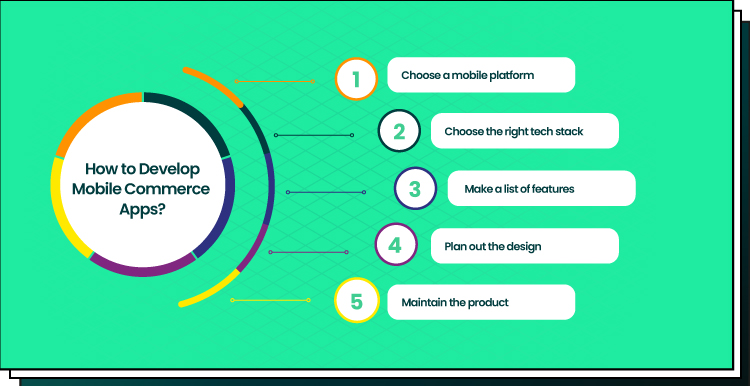
1. Choose the mobile platform
Having a deep understanding of your target audience will help you complete this step successfully. There are several mobile platforms you can choose from, but the main ones are iOS and Android. The choice depends on the platform that your audience uses. Mobile applications that work on a particular platform are called native mobile e-commerce apps.
You can also refer to building a cross-platform or hybrid app. A cross-platform mobile commerce application can run on all platforms. Native m-commerce app development takes more time but allows you to reach a broader audience.
Another option is to build a hybrid mCommerce app. These are faster to develop compared to native apps and require less maintenance effort. Hybrid apps combine the features of web apps and native apps but offer limited access to OS features.
2. Choose the right tech stack
Among the technologies leveraged in mobile development, we may mention React Native, Python, Java, Swift, Kotlin, and many more. The choice of technology depends on the features that you plan to add to your solution, the platform you choose, your resources, and so on. Expertized IT consultants may help you compose the best tech stack for your product and hire a skilled tech team to reach your ecommerce goals.
3. Make a list of features
Sure, the main feature that any m-commerce app includes is the list of products or services that you offer. It’s called a catalog, and it should be easy to navigate. Your users should have the chance to find the needed product or service in a few clicks by searching it directly in the search box or applying filters. Make sure that both features work well.
Add user profiles and location tracking to your app. This will help you collect data on each client and generate marketing insights. Besides, personalized notifications are important for reminding your audience about you and keeping them interested in your products. Notifications can be configured to target a particular client segment, specific occasions, etc.
Also, add social media integration opportunities. Give clients the chance to rate the product, share their feedback on social media platforms, track their Facebook friends’ purchases on your site, etc. Last but not least, you should add convenient mobile payment options that are popular in your target region. To minimize the number of dissatisfied clients, offer convenient customer support features and an easy checkout process.
4. Plan out the design
Your application should be intuitive, laconic, and easy to use and navigate. At the same time, make sure that the design of your mobile e-commerce app reflects your brand identity and differentiates you from competitors. The assistance of skilled UI/UX designers can be a game-changer on your way to building a user-friendly product.
5. Maintain the product
Building a product from scratch is only the start of the journey. Another question is to keep it up and running. As your business grows, the volume of traffic, the number of products, and the number of your app’s features also grow. You need to have a tech team that will offer support and maintenance services for your digital product. This will prevent app crashes, secure client data, and help you grow your online business.
Do you need help with any of these steps? Forbytes specialize in ecommerce development and helps retailers across the globe automate processes, engage customers, and reduce the workload with the help of mCommerce solutions. Get to know us better and let’s cooperate.
Have an M-Commerce App? Facilitate the Experience!
If you already have a mobile commerce application or mobile-friendly site, we invite you to read about the additions that can facilitate client experience with your company. The use of these technologies can renovate the online shopping experience on your site:
- AR. This is one of the most entertaining technologies that you can add to your m-commerce apps or ecommerce sites. Augmented reality (AR) is used by customers to try on the products and visualize their purchases in their personalized context. Using AR helps a client make informed purchase decisions, reduces product return rate, and offers an immersive experience for a customer.
- Big data. Big data technology enables merchants to collect and process big volumes of client data to offer an engaging and personalized customer experience. For humans, collecting and analyzing data manually takes a lot of time. Machines can do it in a few minutes and generate insights that can be then used to promote a brand and drive higher commerce sales.
- AI. Artificial intelligence (AI) is also used for the personalization of ecommerce services. eCommerce AI can power chatbots, automatically display relevant recommendations to a client, help optimize content, prices, and policies using market data and competitor analysis, and much more.
- Mobile retargeting. This is a more sophisticated approach to location-based marketing. Instead of addressing random users, you can target potential clients at the right time and in the appropriate context. For example, you can enable personalized ads for a particular category of users who walk by your store. Or you can send an ad to the users who have frequently opened your mobile commerce app before and are now walking by your shop.
Mobile Commerce Future
Mobile devices can be used for numerous activities that earlier were fulfilled offline or via computers. The number of these activities is increasing daily. This is why we assume that mobile commerce will keep growing year by year. Here is the evidence of this tendency:
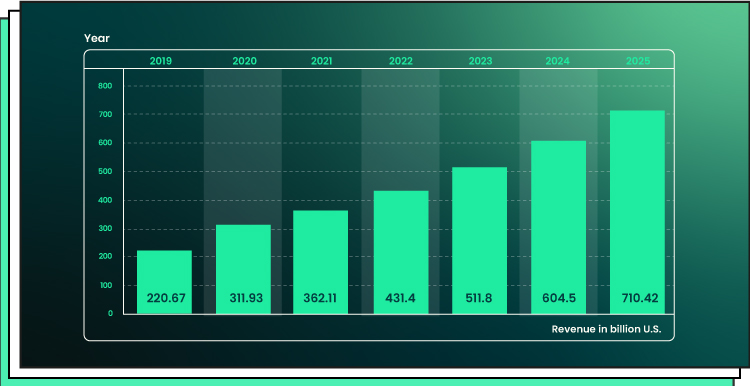
More and more mobile applications will appear on the market. AI-powered chatbots will get smarter and be able to serve complex client needs. So, the mobile shopping experience can be an easy and accessible way to engage clients and help them build robust relationships with your company.
If you need help with building your mobile-first website or mobile ecommerce app, we are at your disposal. eCommerce is one of our focus industries. Forbytes has more than 11 years of experience in ecommerce development. Contact us to plan out and build a product that will help you compete with top representatives of your niche.

Our Engineers
Can Help
Are you ready to discover all benefits of running a business in the digital era?

Our Engineers
Can Help
Are you ready to discover all benefits of running a business in the digital era?
